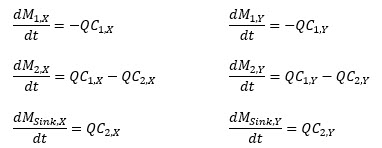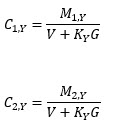Courses: The GoldSim Contaminant Transport Module:
Unit 6 - Modeling Advective Transport Between Environmental Compartments
Lesson 7 - Understanding the Equations for Advective Transport Between Cells with Partitioning
In this Lesson, we will describe the equations for the Exercise we worked on in the previous Lesson (two flow-through tanks with partitioning).
Since we have three Cells (and two species), we have now have six governing equations:

In these equations, M1,X, M2,X and MSink,X represent the mass of X in Tank1, Tank2 and the Sink, respectively; M1,Y, M2,Y and MSink,Y represent the mass of Y in Tank1, Tank2 and the Sink, respectively; C1,X and C2,X represent the concentration of X in Tank1 and Tank2, respectively; and C1,Y and C2,Y represent the concentration of Y in Tank1 and Tank2, respectively. Q represents the constant flow rate through the tanks.
Since X does not partition, we can express C1,X and C2,X as follows:

where V is the volume of water in each tank.
Since Y does partition, as discussed in Unit 3, Lesson 5, we can express C1,Y and C2,Y as follows:

where G represents the mass of Sand in each tank, and KY is the partition coefficient for Y onto Sand.
We won’t bother to do so here, but we could substitute these concentration equations into the governing equations to produce equations that are just a function of the mass in each Cell (and constants). As pointed out in Lesson 5, GoldSim solves these kinds of equations by discretizing time and approximating the time derivative. Again, we won’t bother to do so here, but in a manner that is analogous to what we showed in Lesson 5, this would result in six equations in six unknowns (we have six equations since we have three Cells and two species) that can readily be solved by GoldSim.
In fact, it is more accurate to say we have two sets of three equations, each set having three unknowns. This is because the equations involving the different species are not coupled together at all, and hence can be solved separately. In order for the two sets of equations to be coupled, the two species would need to be involved in a reaction (e.g., species X decaying into species Y) or be isotopes of the same element. We will discuss these special cases in Unit 10.
